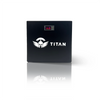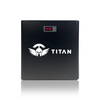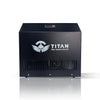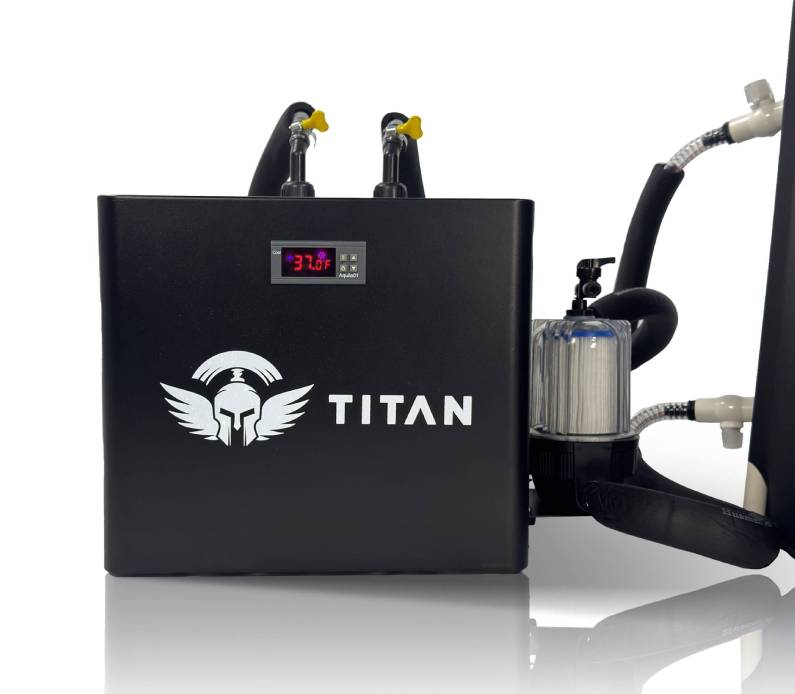
After taking a dip in cold water, your body needs special care. This is because the water is usually around 50 degrees Fahrenheit or colder. A good recovery routine is key to getting the most out of this practice.
We'll show you the important steps to take in the first 10 minutes after your cold plunge. You'll learn how to warm up slowly, drink water, and eat to help your body recover. This will also help reduce muscle soreness and boost your overall health.
By following this routine, you can expect to:
- Enhance your recovery process
- Reduce muscle soreness
- Improve your overall well-being
Immediate Steps After Exiting the Cold Water
When you get out of the cold water, it's key to act fast. This helps your body stay warm. It's a big part of your post-cold immersion protocol.
Drying off well is the first thing to do. Use a cozy towel to dry your skin gently. Focus on your hands and feet. This keeps your body heat in and stops it from escaping.
Then, put on warm, comfy clothes right away. You might wear a soft robe or warm socks. The goal is to keep the heat your body made during the plunge. Here are some tips for dressing:
- Wear dry socks to keep your feet warm.
- Use a robe or warm clothing that covers your body.
- Avoid drafts by staying in a warm room.
It's good to gradually warm up too. Don't change temperature too fast. Let your body warm up slowly, by adding layers or drinking warm drinks.
By following these cold plunge best practices, you get the most from your cold plunge. And you avoid risks. Remember, how you care for yourself after the plunge is just as important as the plunge itself.

Optimal Rewarming Strategies
After a cold plunge, your body is ready for rewarming. This helps keep the benefits of cold therapy and avoids discomfort. Gradual warming keeps your body's circulation and immune response strong.
Gradual Rewarming Techniques
Start by wearing warm, dry clothes right after your cold plunge. This traps your body's heat and slowly raises your core temperature. You can also use a warm blanket or adjust the room temperature to a comfortable level.
Light Exercise and Stretching
Doing light exercise and stretching after a cold plunge boosts recovery. Gentle movements, like walking or yoga, improve blood flow and remove waste from muscles. This reduces muscle soreness and boosts flexibility.
- Promotes Blood Flow: Gentle exercise circulates blood, delivering oxygen and nutrients to muscles.
- Enhances Recovery: Stretching relieves muscle tension and improves range of motion, key for post-plunge care.
- Reduces Muscle Soreness: Light exercise removes waste, reducing muscle soreness after a cold plunge.
| Activity | Benefits | Intensity |
|---|---|---|
| Light Stretching | Improves flexibility, reduces muscle tension | Low |
| Walking | Promotes blood circulation, aids in recovery | Low to Moderate |
| Yoga | Enhances flexibility, reduces stress | Low to Moderate |
Avoid intense workouts right after a cold plunge. Your muscles need time to adjust. Choose low-intensity activities for gentle rewarming and natural recovery.
Hydration and Nutrition Protocol
Cold plunging can cause you to lose important nutrients and electrolytes. It's key to stay hydrated and eat well after a plunge. When you jump into cold water, your body changes in ways that can make you dehydrated and low on nutrients.
To get back what you lost, drink warm liquids. Herbal tea or warm water with lemon are good because they're easy on your stomach. They help your body get back to a healthy balance without shocking you.
Eating a balanced snack or meal is also important. A mix of carbohydrates and proteins helps your muscles recover and gives you energy back. Try to eat something with these nutrients soon after your cold plunge.
Rehydration and Refueling Guidelines
- Drink warm, non-caffeinated beverages to rehydrate.
- Consume a balanced snack or meal that includes carbohydrates and proteins.
- Monitor your body's response and adjust your hydration and nutrition plan as needed.
| Nutritional Element | Recommended Foods/Drinks | Benefits |
|---|---|---|
| Hydration | Herbal tea, warm water with lemon | Replenishes fluids, gentle on the stomach |
| Carbohydrates | Fruits, whole grain crackers | Replenishes energy stores |
| Proteins | Nuts, lean meats, protein shakes | Supports muscle recovery |
By following a good hydration and nutrition plan after your cold plunge, you can improve your recovery. This helps your overall health and makes the benefits of cold plunging even better.

The Complete Post Cold Plunge Routine Timeline
Your post-cold plunge routine should include gradual warming, hydration, and nutrition. This ensures a smooth recovery. By following a structured timeline, you can maximize the benefits of cold plunging and enhance your overall well-being.
Immediate Recovery (0-5 minutes): After exiting the cold water, gently warm yourself up. This can be done through light physical activity or by wrapping yourself in a warm towel. Avoid sudden or extreme changes in temperature.
- Engage in light stretching to promote blood circulation.
- Use a warm towel or blanket to gradually increase your body temperature.
Hydration and Nutrition (5-15 minutes): Replenish lost fluids and provide your body with essential nutrients. Proper hydration and nutrition are key for recovery and maximizing cold plunge benefits.
- Drink water or a warm, non-caffeinated beverage to rehydrate.
- Consume a balanced snack or meal that includes a mix of carbohydrates and proteins.
Gentle Movement (10-30 minutes): Engage in gentle physical activities to promote circulation and flexibility. This can include yoga, light cardio, or a leisurely walk.
By following this complete post-cold plunge routine timeline, you can ensure a smooth and effective recovery. This enhances your overall well-being and maximizes the benefits of cold plunging.
Common Mistakes to Avoid After Cold Plunging
The time after a cold plunge is very important. Knowing what not to do can help you recover better. When you get cold, your body changes to handle the stress. But, what you do right after can help or hurt this process.
One big mistake is taking a hot shower right after. It might feel good to warm up, but it's too sudden. Instead, warm up slowly to let your body adjust.
Key mistakes to avoid:
- Drinking alcohol or caffeine right away, as they can mess with your recovery.
- Doing too much exercise, which can harm your recovery and health.
- Ignoring your body's signals and pushing too hard, which can cause problems.
Refraining from Intense Exercise
After a cold plunge, your body is very alert and sensitive. Doing hard exercise can stress your body more. Instead, do some light stretching or gentle movements to help blood flow without too much effort.
Avoiding these mistakes can make your cold plunge therapy better. The goal is to help your body recover naturally, not stress it out more.
To get the most from your cold plunge, pay attention to what you do after. This way, you can enjoy all the benefits, like better physical recovery and more clear.
Maximizing the Long-Term Benefits of Your Cold Plunge Practice
To get the most out of your cold plunge practice, being consistent is key. Regularly taking cold plunges helps your body get used to the cold. This leads to better tolerance and more benefits over time.
Following a good post cold plunge routine boosts your recovery. This includes rewarming properly, staying hydrated, and eating right. These steps are vital for maximizing cold plunge benefits.
To keep cold plunging a regular part of your life, add it to your daily or weekly routine. Be patient and keep at it. The benefits of cold plunging grow with time. This way, you'll see better physical and mental health, making it a great addition to your wellness plan.
For the best results, use cold plunge recovery tips like slow rewarming and replacing lost nutrients. This helps your body recover well. It lets you enjoy the benefits of regular cold plunges.

FAQ
What are the most important steps to take immediately after a cold plunge?
After a cold plunge, dry off and cover up to avoid a sudden temperature drop. Warm up gently, drink water, and eat to help your body recover and reduce muscle soreness.
How do I dry off and dress warmly after a cold plunge?
Use a warm towel or robe to keep heat in. Wear dry socks to stop heat loss. These steps help warm your body slowly and prevent temperature drops.
What are the best rewarming strategies after a cold plunge?
Start with light exercise, stretching, and cardio to warm up. These activities improve blood flow and help muscles recover, boosting your health.
How do I rehydrate and refuel after a cold plunge?
Drink warm water to rehydrate. Eat a balanced snack or meal to refuel. This replenishes fluids and nutrients, aiding in recovery.
What is the recommended post-cold plunge routine timeline?
A good routine includes warming up, hydrating, eating well, and gentle movement. A step-by-step guide helps tailor a recovery plan that improves your well-being.
What are common mistakes to avoid after cold plunging?
Avoid sudden temperature changes and intense exercise. Stick to a gentle recovery plan to ensure a smooth recovery.
How can I maximize the long-term benefits of my cold plunge practice?
Make cold plunging a regular part of your wellness routine. Be consistent and patient. This approach maximizes benefits like better recovery, less muscle soreness, and overall well-being.
How often should I practice cold plunging to see optimal benefits?
For best results, practice cold plunging 2-3 times a week. Consistency is key to enjoying the full benefits.
Can I do intense exercise immediately after a cold plunge?
No, avoid intense exercise right after. Instead, do light cardio and stretching to help with blood flow and muscle recovery.
What type of nutrition is best after a cold plunge?
Choose a balanced snack or meal with protein, complex carbs, and healthy fats. This replenishes energy and supports muscle recovery.


 30-Day Hassle-Free Returns
30-Day Hassle-Free Returns





